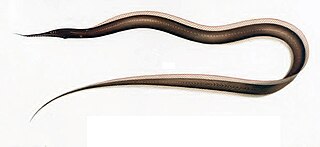
The Congridae are the family of conger and garden eels. Congers are valuable and often large food fishes, while garden eels live in colonies, all protruding from the sea floor after the manner of plants in a garden. The family includes over 220 species in 32 genera.

Nettastomatidae, the duckbill eels or witch eels are a family of eels. The name is from νῆττα and στόμα.

Gymnothorax miliaris, the goldentail moray, bastard eel, or conger moray, is a species of marine fish in the family Muraenidae.

Eels are ray-finned fish belonging to the order Anguilliformes, which consists of eight suborders, 20 families, 164 genera, and about 1000 species. Eels undergo considerable development from the early larval stage to the eventual adult stage and are usually predators.

Ariosoma is a genus of marine congrid eels.

Venefica is a genus of eels in the duckbill eel family Nettastomatidae. It currently contains the following species:

Dysomma is a genus of marine ray-finned fishes belonging to the family Synaphobranchidae, the cutthroat eels. These eels are found in the Atlantic, Indian and Pacific Oceans.

Eels are elongated fish, ranging in length from five centimetres (2 in) to four metres (13 ft). Adults range in weight from 30 grams to over 25 kilograms. They possess no pelvic fins, and many species also lack pectoral fins. The dorsal and anal fins are fused with the caudal or tail fin, forming a single ribbon running along much of the length of the animal. Most eels live in the shallow waters of the ocean and burrow into sand, mud, or amongst rocks. A majority of eel species are nocturnal and thus are rarely seen. Sometimes, they are seen living together in holes, or "eel pits". Some species of eels live in deeper water on the continental shelves and over the slopes deep as 4,000 metres (13,000 ft). Only members of the family Anguillidae regularly inhabit fresh water, but they too return to the sea to breed.
Ariosoma bauchotae is an eel in the family Congridae. It was described by Christine Karrer in 1983. It is a marine, deep water-dwelling eel which is known from waters northwest of Madagascar, in the western Indian Ocean. It is known to dwell at a depth range of 308–314 metres.
Parabathymyrus karrerae is an eel in the family Congridae. It was described by Emma Stanislavovna Karmovskaya in 1991. It is a marine, deep water-dwelling eel which is known from Cape Tala and Madagascar, in the western Indian Ocean. It dwells at a depth range of 260–405 metres.
Blachea xenobranchialis, the frillgill conger is an eel in the family Congridae, and the type species in the genus Blachea. It was described by Christine Karrer and David G. Smith in 1980. It is a tropical, marine eel which is known from northwestern Australia, in the Indo-West Pacific. It dwells at a depth range of 348–385 metres, and leads a benthic lifestyle, inhabiting continental shelves and slopes. Males can reach a maximum total length of 47.5 centimetres, while females can reach a maximum TL of 37.5 cm.
Gnathophis leptosomatus is an eel in the family Congridae. It was described by Christine Karrer in 1983. It is a marine, deep water-dwelling eel which is known from Madagascar, in the western Indian Ocean. It dwells at a depth range of 420–428 metres.
Facciolella karreri is an eel in the family Nettastomatidae. It was described by Wolfgang Klausewitz in 1995. It is a marine, deep water-dwelling eel which is known from the eastern and western Indian Ocean and the western central Pacific Ocean, including the Red Sea, Egypt, Eritrea, Somalia, Saudi Arabia, Yemen and Sudan, and possibly northern Australia. It dwells at a depth range of 700–2000 metres, and is believed to inhabit holes in soft sediments on the sea-bottom. Males can reach a maximum total length of 36.1 centimetres.
Venefica ocella is an eel in the family Nettastomatidae. It was described by Samuel Garman in 1899. It is a marine, deep water-dwelling eel which is known from the eastern Pacific Ocean. It is known to dwell at a depth of 1,953 metres (6,407 ft).
The whipsnout sorcerer is an eel in the family Nettastomatidae. It was described by Léon Vaillant in 1888, originally under the genus Nettastoma. It is a marine, deep water-dwelling eel which is known from tropical, subtropical and temperate areas throughout the world. It dwells at a depth range of 385 to 2,200 metres, and inhabits the lower region of the continental slope. Males can reach a maximum total length of 100 centimetres (39 in).

Venefica procera is an eel in the family Nettastomatidae. It was described by George Brown Goode and Tarleton Hoffman Bean in 1883, originally under the genus Nettastoma. It is a marine, deep water-dwelling eel which is known from the western central Atlantic Ocean, including North Carolina, USA, Suriname, the Gulf of Mexico and the Caribbean Sea. It dwells at a depth range of 326 to 2,304 meters. Males can reach a maximum total length of 109 centimeters (43 in).

Venefica tentaculata is an eel in the family Nettastomatidae. It was described by Samuel Garman in 1899. It is a marine, subtropical eel which is known from the eastern central and northwestern Pacific Ocean, including Mexico, Nicaragua, Japan, and the United States. It dwells at a depth range of 100 to 500 metres, but may dive even deeper. Males can reach a maximum total length of 90 centimetres (35 in).
Ophichthus brachynotopterus is an eel in the family Ophichthidae. It was described by Christine Karrer in 1983. It is a marine, deep water-dwelling eel which is known from Madagascar, in the western Indian Ocean. It dwells at a depth range 355 to 580 metres. Males can reach a maximum total length of 41.6 centimetres (16.4 in).
Dysomma dolichosomatum is an eel in the family Synaphobranchidae. It was described by Christine Karrer in 1983. It is a tropical, marine eel which is known from the Indo-Pacific. It dwells at a depth range of 550–555 metres.
Dysomma polycatodon is an eel in the family Synaphobranchidae. It was described by Christine Karrer in 1983. It is a tropical, marine eel which is known from the Indo-Pacific. It is known to dwell at a depth range of 170–175 metres.









